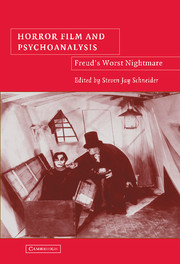Book contents
- Frontmatter
- Contents
- Acknowledgments
- Foreword: “What Lies Beneath?”
- Introduction: “Psychoanalysis in/and/of the Horror Film”
- PART ONE THE QUESTION OF HORROR-PLEASURE
- PART TWO THEORIZING THE UNCANNY
- PART THREE REPRESENTING PSYCHOANALYSIS
- PART FOUR NEW DIRECTIONS
- 12 Doing Things with Theory: From Freud's Worst Nightmare to (Disciplinary) Dreams of Horror's Cultural Value
- 13 The Darker Side of Genius: The (Horror) Auteur Meets Freud's Theory
- 14 Violence and Psychophysiology in Horror Cinema
- Afterword: Psychoanalysis and the Horror Film
- About the Contributors
- Bibliography
- Index
12 - Doing Things with Theory: From Freud's Worst Nightmare to (Disciplinary) Dreams of Horror's Cultural Value
Published online by Cambridge University Press: 14 July 2009
- Frontmatter
- Contents
- Acknowledgments
- Foreword: “What Lies Beneath?”
- Introduction: “Psychoanalysis in/and/of the Horror Film”
- PART ONE THE QUESTION OF HORROR-PLEASURE
- PART TWO THEORIZING THE UNCANNY
- PART THREE REPRESENTING PSYCHOANALYSIS
- PART FOUR NEW DIRECTIONS
- 12 Doing Things with Theory: From Freud's Worst Nightmare to (Disciplinary) Dreams of Horror's Cultural Value
- 13 The Darker Side of Genius: The (Horror) Auteur Meets Freud's Theory
- 14 Violence and Psychophysiology in Horror Cinema
- Afterword: Psychoanalysis and the Horror Film
- About the Contributors
- Bibliography
- Index
Summary
As a genre, horror has provoked a range of theoretical work from academic audiences, work which seeks to make sense of horror's affective powers. In this essay, I want to resituate the theoretical debates that have circulated around horror. By way of pursuing an “alternative paradigm,” I will discuss theoretical work as performative rather than constative. My interest lies not so much in what theories of horror say (i.e., whether they are true or false, metaphysical or falsifiable), but rather in what such theories do. I borrow this distinction from “speech act” theorist J.L. Austin:
The constative utterance, under the name, so dear to philosophers, of statement, has the property of being true or false. The performative utterance, by contrast, can never be either: it has its own special job, it is used to perform an action.
(13)Austin accepts that the “Performative–Constative” antithesis is never absolute, and that the purely “constative” can rarely be disengaged from aspects of performativity (16–17). Even from the constative “side of truth and falsehood,” Austin concludes, “we feel ourselves driven to think again about the Performative–Constative antithesis” (22).
Theoretical work on horror has typically been addressed through a constative lens. This is unsurprising, because it is the habitual orientation of the truth-seeking theorist; a given theory should be, either scientifically or hermeneutically, more adequate than its rivals and should, thus, refer to a state of affairs outside its own model of these affairs.
- Type
- Chapter
- Information
- Horror Film and PsychoanalysisFreud's Worst Nightmare, pp. 205 - 221Publisher: Cambridge University PressPrint publication year: 2004
- 15
- Cited by



